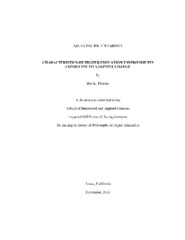| dc.contributor.advisor | Hulme, Eileen E. | en |
| dc.contributor.author | Thomas, Ben L. | en |
| dc.date.accessioned | 2017-08-17T16:01:47Z | |
| dc.date.available | 2017-08-17T16:01:47Z | |
| dc.date.issued | 2016-11 | en |
| dc.identifier.uri | archives.northwestu.edu/handle/nu/25240 | |
| dc.description | A dissertation submitted to Asuza Pacific University's School of Behavioral and Applied Sciences in partial fulfillment of the requirements for the degree Doctor of Philosophy in Higher Education | en |
| dc.description.abstract | Multiple factors, including affordability and expected outcomes, have converged to cause unusual pressure on higher education administrators and faculty and prompt the need for change (Kezar, 2009; Selingo, 2013; Zemsky, 2013). This situation aligns with the adaptive change model because of the focus on identifying innovative solutions for significant challenges (Heifetz, Grashow, & Linsky, 2009; Heifetz & Laurie, 1997). However, the research on successful adaptive change at colleges and universities is limited. This study was initiated to identify environmental characteristics at two exemplar institutions that have been able to implement successful adaptive change on an ongoing basis. For this research, a comparative case analysis methodology was used to study two institutions identified as leaders in higher education in relation to creating and implementing solutions to significant challenges. The research question guiding this study was the following: What are the environmental characteristics within a higher education institution that consistently produce adaptive change? Research was v conducted during a 1-week visit to each campus, with a total of 44 interviews conducted with employees of the 2 institutions. Coding and analysis of the data utilized the NVIVO 10 software to categorize related words and phrases into unit groupings. Themes were then developed to explain how participants described the characteristics of their institution’s environment. Each case was analyzed separately before cross-case synthesis was applied to identify common characteristics as well as themes unique to the institution. The findings indicated that change occurred during 3 distinct phases at each institution: motivating, implementing, and sustaining change. | en |
| dc.format.extent | xii, 345 pages | en |
| dc.format.medium | PDF | en |
| dc.language.iso | en | en |
| dc.publisher | Azusa Pacific University | en |
| dc.rights | This original work is protected by copyright. Copyright is retained by the author(s). Works may be viewed, downloaded, or printed, but not reproduced or distributed without author(s) permission. | en |
| dc.rights.uri | http://archives.northwestu.edu/page/copyright | en |
| dc.title | Characteristics of Higher Education Environments Conducive to Adaptive Change | en |
| thesis.degree.name | Doctor of Philosophy in Higher Education | en |
| thesis.degree.level | Doctoral | en |
| thesis.degree.grantor | Asuza Pacific University | en |
| thesis.degree.discipline | School of Behavioral and Applied Sciences | en |


 Maintained by the Northwest University Library
Maintained by the Northwest University Library